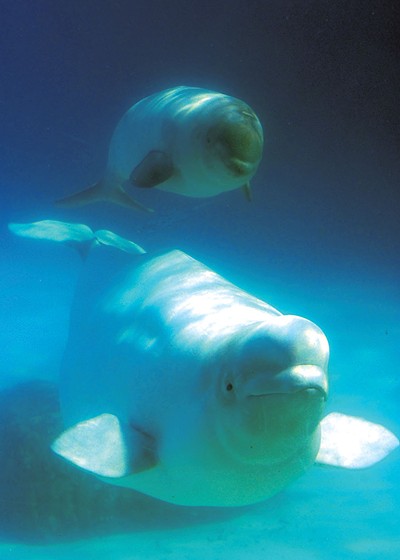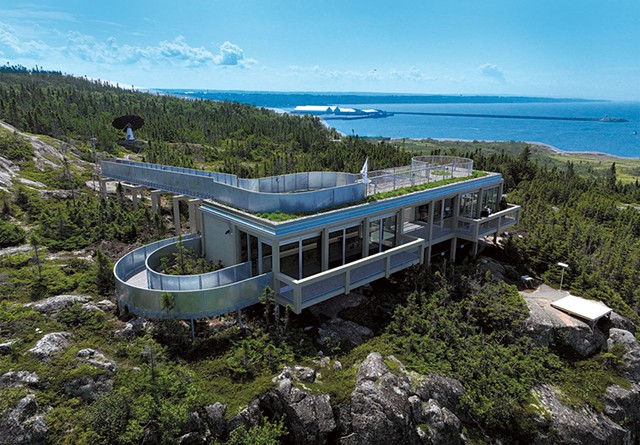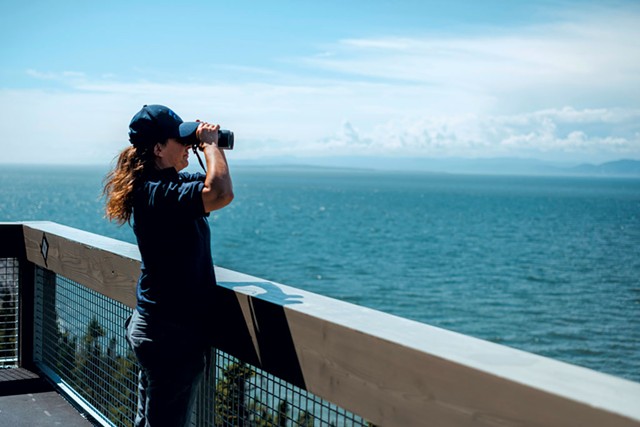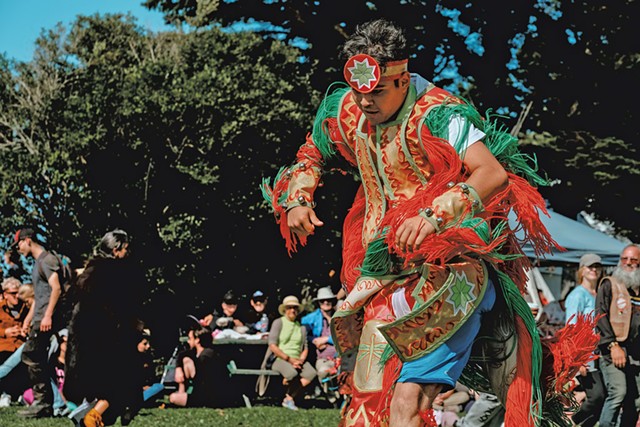
- Courtesy Of Jean-Pierre Sylvestre/Le Québec
- Female beluga and calf
Stand on the summit of Gros-Cacouna mountain, in the coastal Gaspé Peninsula community of Cacouna, and you can gaze for miles across the St. Lawrence Estuary. Its brackish waters rise and recede, tugged by faraway North Atlantic tides. For bigger animals, including whales, it presents a natural buffet: The nutrient-rich confluence of cold seawater with the Saguenay and St. Lawrence rivers draws the krill, capelin and other small fish on which the predators depend.
But of the 13 species of whales you might spot flippering around these parts between May and October, just one — the endangered St. Lawrence Estuary beluga — lives in the waterway year-round. Its small population of roughly 1,850 occupies the species' southernmost range and is genetically distinct from the more northerly belugas. Starting on June 21, visitors will have a new opportunity to spot and learn about these rare whales at an observation deck and research site called Putep't-awt that is opening atop the 272-foot Gros-Cacouna mountain.
"Cacouna is a hot spot for belugas, especially for females with young — the calves are born from the end of June until the middle of September, and Cacouna is a very nice place to see them," said Robert Michaud, president and scientific director of the Tadoussac-based Group for Research and Education on Marine Mammals, which is partnering with the Wolastoqiyik Wahsipekuk First Nation for the launch of Putep't-awt.

- Courtesy Of Origines Photographie
- Putep't-awt
The Cacouna observation deck is the newest of three GREMM-affiliated, land-based beluga viewing sites on the St. Lawrence. For Vermonters, it is also the most accessible. While earlier sites, at Pointe-Noire and Baie Sainte-Marguerite, are on the far side of the waterway, Cacouna is a more feasible 5.5-hour drive from Burlington, a scenic road trip that cuts northeast, then hews to the St. Lawrence's southern shore. Binoculars will be available for visitors to view passing belugas (though Michaud also recommended bringing your own, if you have them).
You might see scientists at work, too. As part of a new project called Window on Belugas, the GREMM team at Putep't-awt will use range-finding binoculars, drones and underwater listening devices called hydrophones to study the social organization and habitat use of the whales, which were hunted commercially here until 1955.
"There is so much we don't understand about belugas," Michaud said. "This project offers a great opportunity to connect the drone images with sounds to study social behavior."
Starting later this summer, visitors will also have the option to sign up for science and cultural programming at Putep't-awt, presented in tandem by GREMM and the Wolastoqiyik Wahsipekuk First Nation. On the scientific side, visitors will follow the progress of marine research firsthand, observing visual and audio footage from land-based GREMM sites and the organization's research vessel.

- Courtesy Of Origines Photographie
- Whale watching
Wolastoqey guides, meanwhile, will share some of the Nation's long history. For at least 8,000 years, the Wolastoqiyik have been traditional guardians of a territory spanning modern-day New Brunswick, Québec and northeastern Maine. (They are sometimes called "Maliseet" in English.) Larry Jenniss, general manager of the Wolastoqiyik Wahsipekuk First Nation, said Grand Chief Jacques Tremblay envisioned Putep't-awt as a way to merge scientific knowledge with ancestral Wolastoqey teachings.
"He wanted to build a bridge between cultures," Jenniss said, "to educate visitors about our traditions and about the beluga, highlighting our role in protecting them."
Jenniss explained that while Western science often isolates a subject and focuses on hard data collected over a relatively short period, Wolastoqey teachings weave together interconnected observations and emotions gathered over centuries and build this information into stories, art, laws and protocols. Jenniss believes that integrating Western science with such Indigenous knowledge can yield a deeper and more nuanced understanding of the natural world. A 1.2-mile interpretive trail at Putep't-awt will debut in June, with interactive panels that delve into the Nation's culture, stories and legends.

- Courtesy Of Origines Photographie
- Wolastoqiyik Wahsipekuk First Nation Pow Wow
While their name translates to "the people of the beautiful and bountiful river," the Wolastoqiyik have only recently begun to rebuild their community's ties to Cacouna, and to each other. After the government seized their reserve in 1869, people scattered, severing cultural and community ties. It wasn't until 1987 that about 100 Wolastoqiyik gathered again to elect a chief and council, re-forming their Nation and starting efforts that are still ongoing to reclaim parts of their ancestral land.
One of their first actions was to construct council offices on the sole surviving piece of their territory — a 60-foot-wide lot not far from Gros-Cacouna mountain, where Putep't-awt is located. "When our ancestors were out on the river, this was the point where they aimed their small canoes to make it safely home," Jenniss said.
It's a place they're proud to share with guests, though the mountain's surroundings have changed significantly from the days when the Wolastoqiyik called this region Wolastokuk and thrived through fishing, agriculture and trade. Since the early 1800s, the south shore of the St. Lawrence has drawn affluent city dwellers from Toronto and Montréal seeking to escape the summer heat; their grand summer homes transformed the then-agricultural villages of Kamouraska, Notre-Dame-du-Portage and Cacouna into 19th-century resort towns. Bas-Saint-Laurent remains a popular tourist draw, its waterside villages offering culinary tourism, historic architecture and outdoor adventures.
That 60-foot-wide lot? It holds a small historic home called Maison Denis-Launière and the Nation's administrative buildings. But nearby Putep't-awt, whose opening next month coincides with Canada's National Indigenous Peoples Day, is key to the Wolastoqiyik Wahsipekuk First Nation's homecoming, too.
"We want to become part of the surrounding communities," Jenniss said, "but we also have our own special story to tell."
If You Go

- Courtesy Of Sébastien St-Jean/Tourisme Côte-nord
- A whale tail
Putep't-awt is in Cacouna, accessible via a 0.9-mile walking trail that starts in a parking lot at the end of route de l'Île, a seven-minute drive from the Boutique D'art Autochtone Matuweskewin (1001 rue du Patrimoine, 418-860-2393). The Wolastoqiyik Wahsipekuk offices and historic homes are also nearby, at 217 rue de la Grève. Look for announcements about tickets and programming at gremm.org and tourismewahsipekuk.ca.
Also in Cacouna, this year's Wolastoqiyik Wahsipekuk First Nation's Pow Wow on August 17 and 18 (malecites.ca/fr/pow-wow) will feature dancers, two drumming groups and singers. The Parc Côtier Kiskotuk (parckiskotuk.com, 418-863-3683) adjoins the observation deck and is popular with bird-watchers.
The homey bed-and-breakfast Gîte La Veilleuse (418-862-8353, double rooms from CA$90 with breakfast) is walking distance from both Putep't-awt and Parc Côtier Kiskotuk. Otherwise, most visitors stay in nearby communities such as Rivière-du-Loup and Notre-Dame-du-Portage, whose century-old riverside Auberge sur Mer (aubergesurmer.ca, 418-862-0642, double rooms from CA$127) has historic rooms in the main building, plus newer motel accommodations and a family-size chalet with a kitchen.







Comments
Comments are closed.
From 2014-2020, Seven Days allowed readers to comment on all stories posted on our website. While we've appreciated the suggestions and insights, right now Seven Days is prioritizing our core mission — producing high-quality, responsible local journalism — over moderating online debates between readers.
To criticize, correct or praise our reporting, please send us a letter to the editor or send us a tip. We’ll check it out and report the results.
Online comments may return when we have better tech tools for managing them. Thanks for reading.